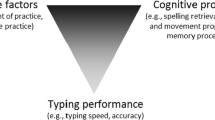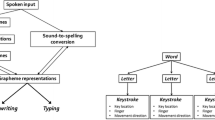Abstract
In 1946, Stella Pajunas, now Mrs. Garnard, typed 216 words in 1 minute using an IBM typewriter (McWhirter, 1981). In 1981, one of us (JL) typed 24 words in 1 minute, also using an IBM machine. The two examples serve to delimit the dimension of skilled typing. At one end, the champion typist succeeds in typing an average of 18 keystrokes per second, giving a mean interresponse time of 55 msec (interresponse time is the time between two successive keystrokes; words are considered to consist of five characters, including a space). At the other end of the dimension, the hunt-and-peck typist manages to type only an average of 2 keystrokes per second, giving a mean interresponse time of 500 msec. The champion is almost 10 times as fast as the beginner. Although speed is one of the most noticeable differences between these two levels of skill, other differences are as easily observed.
Access this chapter
Tax calculation will be finalised at checkout
Purchases are for personal use only
Preview
Unable to display preview. Download preview PDF.
Similar content being viewed by others
References
Reference Notes
Gentner, D. R., Grudin, J., & Conway, E. Finger movements in transcription typing (Tech. Rep. NR 157–437). Personnel and Training Research Programs, Office of Naval Research, Arlington, Va., 1980.
Permutt, T. J. Applied field project report for diploma in mathematical statistics. Unpublished essay, Cambridge University Statistical Laboratory, 1975.
Johnson, N. L. (1970). Tables to facilitate fitting SB curves (Mimeo Series No. 557). University of North Carolina, Institute of Statistics.
Rumelhart, D., & Norman, D. Simulating a skilled typist: A study of skilled cognitive-motor performance (Tech. Rep. 102). La Jolla, Calif.: University of California at San Diego, Center for Human Information Processing, May 1981.
Fletcher, J. H. An interim report on aptitude tests for postal coding desk operators and coding desk keyboards. Dollis Hill, London: Post Office Research Department, 1974.
Glencross, D. J. The Flinders typing project. South Australia: Flinders University Report, 1976.
References
Adams, J. A. Response feedback and learning. Psychological Bulletin, 1968, 70, 486–504.
Adams, J. A. A closed-loop theory of motor learning. Journal of Motor Behavior, 1971, 3, 111–150.
Allen, R. A. Composition and editing of text. Ergonomics, 1981, 24, 611–622.
Annett, J. Feedback and human behaviour. Harmondsworth: Penguin, 1969.
Baddeley, A. D., & Longman, D. J. A. The influences of length and frequency of training sessions on the rate of learning to type. Ergonomics, 1978, 21, 627–635.
Card, S. K., Moran, T. P., & Newell, A. Computer text editing: An information processing analysis of a routine cognitive skill. Cognitive Psychology, 1980, 12, 32–74.
Crooks, M. Touch typing for teachers. London: Pitman, 1964.
Droege, R. C., & Hill, B. M. Comparison of performance on manual and electric typewriters. Journal of Applied Psychology, 1961, 45, 268–270.
Elderton, W. P., & Johnson, N. L. Systems of frequency curves. New York and London: Cambridge University Press, 1969.
Everitt, B. B., & Hand, D. J. Finite mixture distributions. London: Chapman and Hall, 1981.
Finucan, H. M. A note on kurtosis. Journal of the Royal Statistical Society (Series B),1964, 26,111–112.
Fitts, P. M., & Posner, M. I. Human performance. Belmont, Calif.: Brooks/Cole, 1967.
Fleishman, E. A. Toward a taxonomy of human performance. American Psychologist, 1975, 30, 1127–1149.
Gould, J. D. Composing letters with computer-based text editors. Human Factors, 1981, 23, 593–606.
Kelso, J. A. S. Contrasting perspectives on order and regulation in movement. In J. B. Long & A. D. Baddeley (Eds.), Attention and performance (Vol. 9 ). Hillsdale, N.J.: Erlbaum, 1981.
Kendall, M. G., & Stuart, A. The advanced theory of statistics (3rd ed., Vol. 1 ). London: Charles Griffin, 1969.
Kinkead, R. Typing speed, keying rates, and optimal keyboard conjoints. Proceedings, 19th Annual Human Factors Society Meeting, 1975.
Long, J. B. Effects of randomly delayed visual and auditory feedback on keying performance. Ergonomics, 1975, 18, 337–347.
Long, J. B. Visual feedback and skilled keying: Differential effects of masking the printed copy and the keyboard. Ergonomics,1976, /9, 93–110. (a)
Long, J. B. Effects of delayed irregular feedback on unskilled and skilled keying performance. Ergonomics, 1976, 19, 183–202. (b)
McWhirter, N. (Ed.) Guinness book of records. Enfield, London: Guinness Superlatives, 1981.
Neal, A. S. Time intervals between keystrokes, records, and fields in data entry with skilled operators. Human Factors, 1977, 19, 163–170.
Olsen, R. A., & Murray, R. A. Finger motion analysis in typing of texts of varying complexity. Proceedings of the 6th Congress of the International Ergonomics Association, 1976, 446–450.
Pearson, E. S., & Hartley, H. O. Biometrika tables for statisticians (Vol. 2 ). New York and London: Cambridge University Press, 1972.
Pearson, E. S., & Please, N. W. Relation between the shape of population distributions and the robustness of four simple test statistics. Biometrika, 1975, 62, 223–241.
Pew, R. The speed-accuracy operating characteristic. Acta Psychologica, 1969, 30, 16–26.
Pew, R. W. Human perceptual-motor performance. In B. H. Kantowitz (Ed.), Human information processing: Tutorials in performance and cognition. Hillsdale, N.J.: Erlbaum, 1974.
Pollard, D., & Cooper, M. B. The effect of feedback on keying performance. Applied Ergonomics, 1979, 10, 194–200.
Rabbitt, P. Cognitive psychology needs models for change in performance with old age. In J. B. Long and A. D. Baddeley (Eds.), Attention and performance (Vol. 9 ). Hillsdale, N.J.: Erlbaum, 1981.
Scheidegger, W. Learn with Scheidegger (8th ed., Booklet 3 ). London: Scheidegger, 1969.
Schmidt, R. A. A schema theory of discrete motor skill learning. Psychological Review, 1975, 82, 225–260.
Schmidt, R. A. The schema as a solution to some persistent problems in motor learning theory. In G. E. Stelmach (Ed.), Motor control: Issues and Trends. New York: Academic Press, 1976.
Seibel, R. Data entry devices and procedures. In H. P. Van Cott and R. G. Kincade (Eds.), Human engineering guide to equipment design. Washington, D.C.: American Institutes for Research, 1972.
Shaffer, L. H. Control processes in typing. Quarterly Journal of Experimental Psychology, 1975, 27, 419–432.
Shaffer, L. H. Intention and performance. Psychological Review, 1976, 83, 375–393.
Shiffrin, R. M., Dumais, S. T., & Schneider, W. Characteristics of automatism. In J. B. Long and A. D. Baddeley (Eds.), Attention and performance (Vol. 9 ). Hillsdale, N.J.: Erlbaum, 1981.
Sternberg, S., Monsell, S., Knoll, R. L., & Wright, C. E. The latency and duration of rapid movement sequences: Comparisons of speech and typewriting. In G. E. Stelmach (Ed.), Information processing in motor control and learning. London: Academic Press, 1978.
Summers, J. J. Motor programs. In D. Holding (Ed.), Human skills. Chichester: Wiley, 1981.
Viviani, P., & Terzuolo, C. Space-time invariance in learned motor skills. In G. E. Stelmach and J. Requin (Eds.), Tutorials in motor behavior. Amsterdam: North-Holland, 1980.
Walker, E. L. Conditioning and instrumental learning. Belmont, Calif.: Brooks/Cole, 1967.
West, L. J. Acquisition of typewriting skills. New York: Pitman, 1969.
Editor information
Editors and Affiliations
Rights and permissions
Copyright information
© 1983 Springer-Verlag New York Inc.
About this chapter
Cite this chapter
Long, J., Nimmo-Smith, I., Whitefield, A. (1983). Skilled Typing: A Characterization Based on the Distribution of Times Between Responses. In: Cooper, W.E. (eds) Cognitive Aspects of Skilled Typewriting. Springer, New York, NY. https://doi.org/10.1007/978-1-4612-5470-6_7
Download citation
DOI: https://doi.org/10.1007/978-1-4612-5470-6_7
Publisher Name: Springer, New York, NY
Print ISBN: 978-1-4612-5472-0
Online ISBN: 978-1-4612-5470-6
eBook Packages: Springer Book Archive




